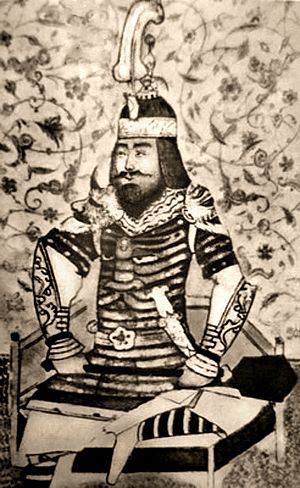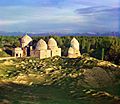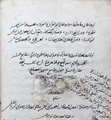Tamerlane facts for kids
Quick facts for kids  |
|
| Reign | 1370-1405 |
|---|---|
| Coronation | 1370, Balkh |
| Predecessor | Amir Husayn |
| Successor | Khalil Sultan |
| Born | April 8, 1336 Shahrisabz, Uzbekistan |
| Died | February 18, 1405 (aged 68) Otrar, Syr Darya |
| Burial | Gur-e Amir, Samarkand |
| House | Timurid |
| Father | Muhammad Taraghai |
| Mother | Tekina Mohbegim |
| Religion | Islam |
Tamerlane (born April 8, 1336 – died February 18, 1405) was a powerful Turkic leader and conqueror. He lived in the 14th century. His real name was Tīmūr bin Taraghay Barlas. People also knew him by names like Timur, Timur Lenk, and Amir Timur. He built a huge empire that stretched across many lands. This included areas like Uzbekistan, Afghanistan, Persia (modern-day Iran), Syria, and parts of India and Russia. Tamerlane is seen as one of the last great nomadic conquerors. His empire helped set the stage for later powerful empires.
Contents
Who Was Tamerlane?
Tamerlane was a skilled military leader. He started his career by taking control of Transoxania. This area is now known as Uzbekistan. He used smart political moves and military fights to gain power. For ten years, he worked with other rulers. He fought to expand his territory. He even helped the Khan empire against the Russians. Tamerlane defeated many large armies. This was just the start of his journey to build a vast empire.
Tamerlane's Early Conquests
In 1383, Tamerlane began conquering Persia. He challenged several ruling families there. His goal was to protect his growing empire. He also wanted to make it even bigger. He managed to secure most of eastern Persia. He also defeated a major Mongol king named Tokhtamysh. After this victory, Tamerlane and his army occupied Moscow for a year.
Dealing with Rebellions
While Tamerlane was away from Persia, some revolts started. People tried to regain control of their regions. But Tamerlane's strong military put down all these uprisings. He knew his home city of Samarkand was safe. His forces were managing it well. This allowed him to move on to new campaigns.
Tamerlane's Invasion of India
Tamerlane then decided to attack India. He believed the rulers there were too accepting of their Hindu subjects. In 1398, he crossed the Indus River. He marched his army into Delhi. His conquest caused a lot of damage to the city. This event was a big setback for the region.
The Spoils of War
After his victory in India, Tamerlane left with a huge amount of treasure. He used 90 captured elephants to carry it all. He also took stones from quarries. These were used to build a grand mosque in his homeland. This shows how much wealth he gained from his conquests.
Further Campaigns and Legacy
In 1399, Tamerlane planned a new military trip. He wanted to attack the Sultan of Egypt. He believed the Sultan had taken some of his territory. He marched into Syria and captured the city of Aleppo. In 1401, his army took over Damascus. That same year, he attacked Baghdad. He caused great destruction there. Many buildings and important monuments were destroyed.
The Final Journey
Tamerlane and his army of 200,000 soldiers set out for China. They traveled through deep snow and frozen rivers. They stopped in what is now Kazakhstan to rest. During this journey, Tamerlane became sick with a cold. He sadly died there. The plan to conquer China was immediately stopped. His body was taken back to Samarkand. He was buried in the Gur Amir mausoleum. His coffin was made of steel. It was placed under a long slab of black jade. The stone had an inscription that read: “This is the resting place of the illustrious and merciful monarch, the most great sultan, the most mighty warrior, Lord Timur, Conqueror of the World.”
Images for kids
-
Emir Timur feasts in the gardens of Samarkand.
-
Map of the Timurid Empire
-
Timur orders campaign against Georgia.
-
Timur defeats the Sultan of Delhi, Nasir Al-Din Mahmud Tughluq, in the winter of 1397–1398, painting dated 1595–1600.
-
Bayezid I being held captive by Timur
-
Timur had aligned himself with the remnants of the Yuan dynasty in his attempts to conquer Ming China.
-
Letter of Timur to Charles VI of France, 1402, a witness to Timurid relations with Europe.
-
Emir Timur and his forces advance against the Golden Horde, Khan Tokhtamysh.
-
A forensic facial reconstruction of Timur by M. Gerasimov (1941)
-
Timurid Mosque in Herat.
-
Green Mosque (Balkh) is a Timurid mosque that inspired Shah Jahan.
-
Mausoleum of Khoja Ahmed Yasawi, a prime example of Timurid architecture.
See also
 In Spanish: Tamerlán para niños
In Spanish: Tamerlán para niños

























